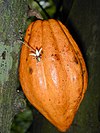Dark chocolate
This article needs additional citations for verification. (August 2021) |
Dark chocolate is a form of chocolate containing cocoa solids and cocoa butter, without the milk or butter found in milk chocolate.[1] Government and industry standards of what products may be labeled "dark chocolate" vary by country and market.[1]
There is no high-quality evidence for any health effects of dark chocolate, such as on blood pressure.[2]
History[]
Chocolate is made from the tropical Theobroma cacao tree seeds. Dark chocolate has been around for over 3,000 years.[1] It was developed around 1900 B.C in Central and South America as a drink.[citation needed] Later, it was also made into a drink for the Aztecs and Mayans for ceremonial purposes.
The Spanish encountered chocolate in the early 1500s and brought it back to Europe; they would add honey and cane sugar to make it sweeter and this led to manufacturing of milk chocolate.[3] In the late 1600s, milk was added to the dark chocolate beverage by Hans Sloane, who resided in Jamaica at the time. It is argued that milk chocolate was first invented by Daniel Peter and Henri Nestle who added condensed milk to dark chocolate in 1847. Soon after, chocolate was made into a solid form and started to be mass-produced in the 20th century.[1]
Research[]
As of 2018, high-quality clinical research has not been conducted to evaluate the effects of compounds found in cocoa on physiological outcomes, such as blood pressure, for which only small (1–2 mmHg) changes resulted from short-term consumption of chocolate up to 105 grams and 670 milligrams of flavonols per day.[2] Flavanols found in dark chocolate include the monomers catechin and epicatechin, and (to a lesser extent) the polymeric procyanidins, which remain under laboratory research.[2]
Nutritional content[]
| Nutritional value per 100 g (3.5 oz) | |
|---|---|
| Energy | 2,500 kJ (600 kcal) |
45.9 g | |
| Sugars | 24 g |
| Dietary fiber | 10.9 g |
42.6 g | |
| Saturated | 24.5 g |
| Trans | 0.03 g |
| Monounsaturated | 12.8 g |
| Polyunsaturated | 1.26 g |
7.79 g | |
| Vitamins | Quantity %DV† |
| Vitamin A equiv. | 0% 2 μg |
| Vitamin A | 39 IU |
| Thiamine (B1) | 3% 0.034 mg |
| Riboflavin (B2) | 7% 0.078 mg |
| Niacin (B3) | 7% 1.05 mg |
| Pantothenic acid (B5) | 8% 0.418 mg |
| Vitamin B6 | 3% 0.038 mg |
| Vitamin B12 | 12% 0.28 μg |
| Vitamin E | 4% 0.59 mg |
| Vitamin K | 7% 7.3 μg |
| Minerals | Quantity %DV† |
| Calcium | 7% 73 mg |
| Copper | 89% 1.77 mg |
| Iron | 92% 11.90 mg |
| Magnesium | 64% 228 mg |
| Manganese | 93% 1.95 mg |
| Phosphorus | 44% 308 mg |
| Potassium | 15% 715 mg |
| Selenium | 10% 6.8 μg |
| Sodium | 1% 20 mg |
| Zinc | 35% 3.31 mg |
| Other constituents | Quantity |
| Water | 1.37 g |
| Caffeine | 80 mg |
| Cholesterol | 3 mg |
| |
| †Percentages are roughly approximated using US recommendations for adults. Source: USDA FoodData Central | |
Nutrients in dark chocolate include 46% carbohydrates, 43% fats, 8% protein, and 1% water (table). In a 100-gram (3+1⁄2-ounce) reference serving, dark chocolate provides 2,500 kilojoules (600 kilocalories) of food energy and is a rich source (defined as more than 20% of the Daily Value, DV) of several dietary minerals, such as iron, copper, manganese, magnesium, phosphorus, and zinc. It also contains moderate amount of vitamin B12 (table).
See also[]
References[]
- ^ Jump up to: a b c d Tara Mchugh (16 April 2016). "How dark chocolate is processed". PhysOrg. Retrieved 19 November 2019.
- ^ Jump up to: a b c Ried, K.; Sullivan, T. R.; Fakler, P.; Frank, O. R.; Stocks, N. P. (25 April 2017). "Effect of cocoa on blood pressure". The Cochrane Database of Systematic Reviews. 4 (4): CD008893. doi:10.1002/14651858.CD008893.pub3. PMC 6478304. PMID 28439881.
- ^ Notter, Ewald (18 January 2011). The Art of the Chocolatier: From Classic Confections to Sensational Showpieces. John Wiley & Sons. ISBN 978-0-470-39884-5.
| Wikimedia Commons has media related to Dark chocolate. |
- Types of chocolate

